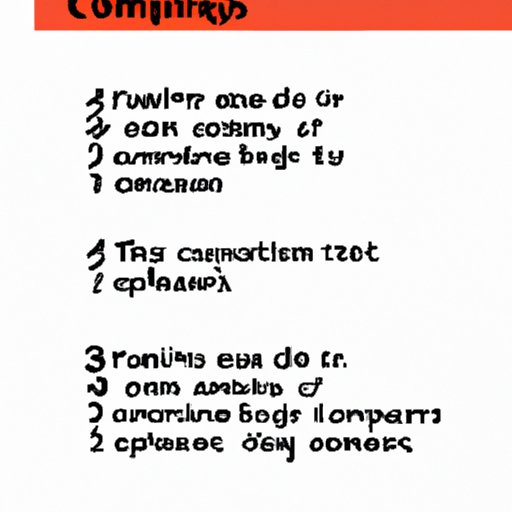
Introduction
As a writer, proper comma usage is integral to effective communication. Commas help to clarify meaning and break up sentences for smoother reading. Misused or omitted commas can cause confusion, ambiguity, or even alter the intended meaning of a sentence. This article serves as a comprehensive guide to using commas, covering everything from basic usage to advanced techniques.
A Step-by-Step Guide to Comma Usage: Tips for Beginners
Commas serve as essential punctuation marks that help readers understand a writer’s message. Commas separate clauses, phrases and words within a sentence. The following are some simple comma usage rules to get you started:
- Use a comma to separate items in a list or series, e.g. “red, green, and blue.”
- Use a comma to set off an introductory phrase or clause, e.g. “After eating breakfast, George went for a walk.”
- Use a comma to set off a non-essential element, e.g. “Charles, the tallest boy in class, wore a red shirt.”

The Comma Usage Guide for the Advanced Writer: Mastering the Art of Punctuation
Once you have mastered basic comma usage, you can start exploring more advanced techniques that help to convey your intended meaning more accurately and effectively. Here are some advanced comma usage rules:
- Use a comma to set off appositives, e.g. “My friend, the doctor, is always on call.”
- Use a comma to indicate a shift in thought or tone within a sentence, e.g. “He was a great athlete, no doubt, but he lacked discipline.”
- Use a comma to set off a quotation, e.g. “He said, ‘I’ll be there soon.'”
It’s important to note that advanced comma usage requires practice and attention to detail. Using an advanced technique can backfire if it is not used properly, so be sure to understand the rules before applying them to your writing.
The Top 7 Most Common Comma Mistakes and How to Avoid Them
Despite understanding basic comma usage, writers often make common mistakes when it comes to the placement of commas. Here are the top seven comma mistakes:
- Using a comma splice, e.g. “She loved painting, he preferred drawing.”
- Omitting a comma in a compound sentence, e.g. “Rose likes to paint and draw.”
- Placing a comma after a coordinating conjunction, e.g. “She ate a sandwich, and drank some tea.”
- Not using a comma after an introductory phrase, e.g. “At first he was nervous.”
- Placing a comma where it’s not needed, e.g. “He didn’t like, his new car”
- Using a comma with the word “that,” e.g. “I believe that, it’s a good idea.”
- Using a comma with a restrictive clause, e.g. “She enjoys hiking, which she does every weekend.
By avoiding these mistakes, your writing will be clearer and more professional.
Comma Usage: Knowing the Rules and When to Break Them
While it’s important to know the rules of comma usage, experienced writers know that sometimes it’s necessary to break them to achieve a particular effect. Here are some examples when it’s appropriate to break the rules:
- When using a literary device like anastrophe or chiasmus, e.g. “The water lilies, each a tiny galaxy, spread across the pond.”
- To create a particular rhythm or cadence in a sentence, e.g. “The wind sighed through the trees, the leaves rustling and whispering secrets.”
- To create emphasis or to clarify meaning, e.g. “I said I wanted roses, not tulips.”
It takes practice to break the rules and use commas effectively in a creative way. However, when done correctly, it can elevate your writing to a new level.
Using Commas in Lists and Series: Making Your Writing More Readable
Using commas effectively in lists and series can make your writing more readable. Here are some helpful tips:
- In horizontal lists, use commas to separate items, e.g. “She enjoyed reading, writing, and watching movies.”
- In vertical lists, separate items with a comma and use “and” before the last item, e.g. “I need to buy eggs, milk, bread, and butter.
- In series, use commas to separate items within each pair of items, e.g. “The painting was large, colorful, and expressive.”
How to Use Commas to Set Off Parenthetical Elements
Commas can be used to set off parenthetical elements within a sentence, such as interjections or non-essential phrases or clauses. Here are some tips:
- Use a comma to set off interjections, e.g. “Oh, I’m so glad to see you.”
- Use a comma to set off non-essential phrases or clauses, e.g. “My cousin, who is an artist, painted a beautiful portrait of my dog.”
- Use a comma to set off a non-restrictive clause, e.g. “The dog that was barking earlier is now quiet.”
How to Punctuate Dialogue with Commas: Make Your Characters Speak
When writing dialogue, proper punctuation is key to making your characters’ speech clear and realistic. Here are some tips:
- Use a comma to separate dialogue from its tag, e.g. ” “I’ll be there soon,” he said.”
- Use a comma to indicate a pause in speech, e.g. ” “I don’t know,” she hesitated.”
- Use a comma to separate dialogue between multiple speakers, e.g. ” “I think we should go,” said Tom. “Agreed,” replied Jane.”
Conclusion
Proper comma usage is essential for effective communication. By following the rules outlined in this article, you can improve the clarity and professionalism of your writing. Remember that comma usage, while based on rules, is also an art form. When used creatively and appropriately, commas can add depth and meaning to your writing.




